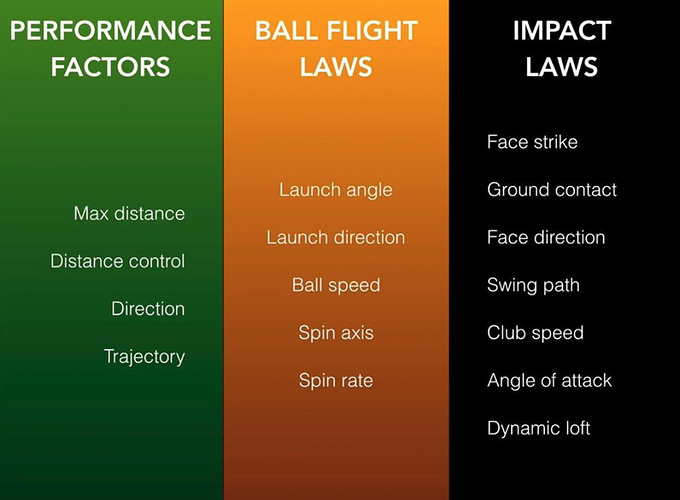I thought I would share a little info about how I, as a coach, think about game improvement. The process is the same, regardless of whether it’s a tour pro, or a complete beginner in front of me.
- I look at the performance needs of the player. Usually, I sue strokes gained concepts to see which of the 4 performance parameters the player would get the most benefit from improving. The four parameters are Max distance, distance control, directional control or trajectory
- Then I link their desired performance parameter to the ball flight laws and see which one (or more) of those needs to improve. There are 5 ball flight laws - Launch angle, spin rate, launch direction, spin axis and ball speed
- I then link the ball flight laws to the desired impact factors that will influence them. There are 7 impact laws - ground contact, face contact, face direction, club speed, swing path, dynamic loft and angle of attack.
- I then draw from a multitude of possible interventions - everything from a simple concept (like explaining low point) to more technical interventions, such as a change in the backswing.
Here is an image displaying this
A specific example of this might look like
-
Player has max distance issues with the driver (performance)
-
Their spin rate is high and launch angle is low (ball flight laws)
-
We could move the strike higher on the face (impact laws)
-
The coaching intervention could simply be teeing up higher and working on their arc depth control through the 3D aimpoint concept (see pic below)

Striking higher on the face will create the higher launch and lower spin this player needs to pick up yardage.
It may seem like a complex process, but it’s all automatic for me currently. The main thing I would like to get across is to view improvement from a performance first perspective, and at the very least relate that to the impact factors.
This is different to how I see many amateurs approach improvement, which usually looks like
-
Hit it poor
-
Pick random swing thing that the latest in-vogue pro does and try it
-
Repeat, ad infinitum
This process is fraught with many errors. What a pro does may require 2/3/or more other match ups to make it work, and adding it to your swing might make you worse. For example, try doing a shallower shaft position (like the pros) when you have a wide open face and you are in for a bad time.
I hope the above is not too much info. I certainly don’t expect players to think like this, but to at least have a small understanding of the links that should be made between performance and what drives it (impact physics). Take from the above what you need, and discard the rest


